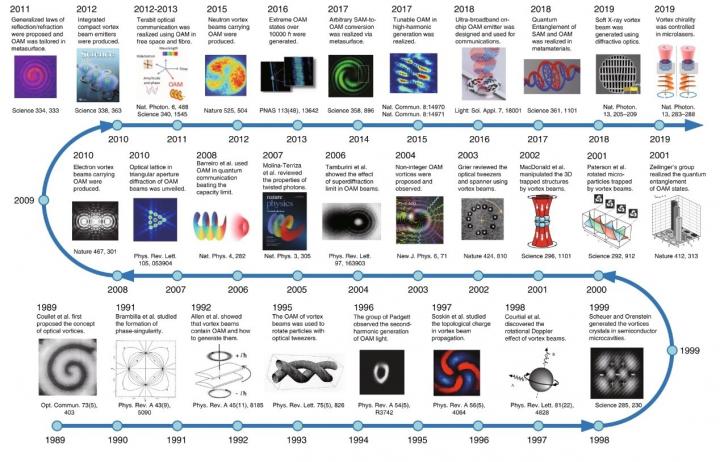
Credit: Yijie Shen, Xuejiao Wang, Zhenwei Xie,Changjun Min , , Qiang Liu, Mali Gong, Xiaocong Yuan
Vortices are common phenomena that widely exist in nature, from quantum vortices in liquid nitrogen to ocean circulation and typhoon vortices and even to spiral galaxies in the Milky Way. Vortices also exist in optics, the concept of which was first proposed by theoretical physicist Pierre Coullet and colleagues [Opt. Commun. 73, 403 (1989)] thirty years ago. Hitherto, owing to their amazing structures, optical vortices (OVs) have engendered tremendous advanced applications such as optical tweezers, quantum entanglement, nonlinear optics, throughout every branch of modern optics.
They divided the 30-year development of OVs into three stages: the first 10 years is the fundamental theories stage that new physical concepts and novel physical phenomena were put forward during this stage, such as topological charge, phase singularity, vortex lattice, orbital angular momentum (OAM), and vortex beams with the spiral wave front, which laid solid theoretical foundations for the subsequent scientific applications; the second 10 years is the application development stage that due to the characteristics of singular phase of OV and high dimension of OAM, optical vortices bring a unique kind of light sources with superior performance for the applications of quantum technology, optical tweezers and particle manipulation, super-resolution imaging, biomedical and chemical detection, high-capacity optical communication etc.; The recent 10 years is the technology breakthrough stage that metasurface has brought OV into nanoscale, OAM-multiplexing has extended the capacity of optical communication to terabit- even petabit-level, and improved tunability of OV has realized novel nonlinear and quantum phenomena, pushing OV as one of the hottest scientific topics.
In this review paper, they also explained how the concept of optical vortices emerged from observed similarities between the behavior of fluid vortices and some forms of laser light. The light waves of optical vortices are twisted around their direction of travel, with a point of zero intensity at their center. The authors surveyed the steady refinement of techniques used to create optical vortices, and explore their applications. They emphasized that the tunability of OVs includes not only the spectral and temporal tunability but also the OAM-, chirality-, topological-charge-, and singularity-distribution tunability. Prominent applications include sophisticated optical computing processes, novel microscopy and imaging techniques, the creation of ‘optical tweezers’ to trap particles of matter, and optical machining using light to pattern structures on the nanoscale.
###
Media Contact
Xing Fu
[email protected]
Related Journal Article
http://dx.



